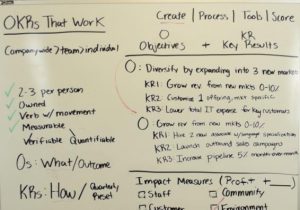What's the Best Way to Write an OKR?
Writing effective Objectives and Key Results (OKRs) is crucial for aligning team efforts with organizational goals and driving success. This article delves into the best practices for crafting OKRs that are clear, motivational, and quantifiable, ensuring that everyone in your team knows exactly what success looks like.

Start with a Strong Objective
Your objective should be ambitious yet achievable, providing a clear direction that inspires your team. It should be stated in a way that is straightforward and stirs enthusiasm. For instance, instead of saying "increase sales," specify "Dominate the Midwestern market."
Craft Measurable Key Results
Key results should be specific metrics used to measure progress towards the objective. They need to be quantifiable and time-bound, providing a clear target to aim for. A well-written key result for the objective "Dominate the Midwestern market" might be, "Achieve 30% market share in the Midwest by Q4."
Ensure Alignment with Overall Strategy
Each OKR should directly support the strategic goals of your organization. Alignment ensures that every team’s efforts contribute towards a unified vision, maximizing the impact of your initiatives. This requires that the OKRs are not only discussed at the top levels but are also understood and embraced across the organization.
Use Action-Oriented Language
When writing your key results, use action-oriented language that conveys a sense of urgency and purpose. Phrases like "launch," "develop," "increase," and "reduce" clarify what actions are necessary to achieve the goals. This approach keeps the team focused on activities that drive results.
Set a Time Frame
Every key result must include a specific deadline. This not only provides urgency but also helps in planning and resource allocation. For example, saying "increase customer base by 20% in 6 months" sets a clear timeline for achieving the growth needed.
Include Stretch Goals
While your OKRs should be achievable, they should also challenge your team. Stretch goals encourage out-of-the-box thinking and innovative approaches. They can be particularly motivating, pushing teams to exceed their standard limits and achieve exceptional results.
Regularly Review and Revise
OKRs are not set in stone. They should be reviewed regularly to reflect any changes in strategy or external conditions. This adaptability ensures that your team remains focused on the most relevant and impactful goals.
Communicate Openly and Frequently
Ensure that all team members understand the OKRs by communicating them clearly and frequently. Regular updates on progress, as well as any adjustments to the OKRs, should be shared to keep everyone informed and engaged.
Utilizing the Best Practices in OKR Writing
When you master how to write OKR, you harness the power to streamline your organization's efforts and push towards achieving key strategic goals. By setting clear, aligned, and challenging OKRs, you can create a roadmap for success that is understood and embraced by the whole team.
By following these steps, you can ensure that your OKRs are not just well-written, but are powerful tools for driving performance and achieving remarkable results. These practices foster a culture of accountability and achievement, setting your team up for success in every endeavor.